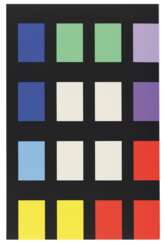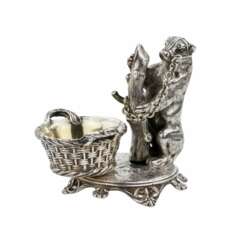ours

Aurélie Nemours is a French abstractionist painter.
Aurélie Nemours created abstract geometric paintings, developing her own style based on pure colors and geometric shapes taken from the square, but without dogmatism or systematism. Her compositions are strictly arranged on a plane based on the intersection of horizontal and vertical. This painstaking work culminates in a meditative asceticism confined to squares and rectangles, black or gray, space and matter.


Aurélie Nemours is a French abstractionist painter.
Aurélie Nemours created abstract geometric paintings, developing her own style based on pure colors and geometric shapes taken from the square, but without dogmatism or systematism. Her compositions are strictly arranged on a plane based on the intersection of horizontal and vertical. This painstaking work culminates in a meditative asceticism confined to squares and rectangles, black or gray, space and matter.


Aurélie Nemours is a French abstractionist painter.
Aurélie Nemours created abstract geometric paintings, developing her own style based on pure colors and geometric shapes taken from the square, but without dogmatism or systematism. Her compositions are strictly arranged on a plane based on the intersection of horizontal and vertical. This painstaking work culminates in a meditative asceticism confined to squares and rectangles, black or gray, space and matter.


Aurélie Nemours is a French abstractionist painter.
Aurélie Nemours created abstract geometric paintings, developing her own style based on pure colors and geometric shapes taken from the square, but without dogmatism or systematism. Her compositions are strictly arranged on a plane based on the intersection of horizontal and vertical. This painstaking work culminates in a meditative asceticism confined to squares and rectangles, black or gray, space and matter.


Marc Chagall (Russian: Марк Заха́рович Шага́л), born Moishe Shagal in 1887 near Vitebsk, Belarus (then part of the Russian Empire), was a Belarusian and French artist celebrated for his pivotal role in the avant-garde movement and his unique integration of Eastern European Jewish culture into modern art. His contributions spanned several artistic formats including painting, stained glass, stage sets, ceramics, tapestries, and fine art prints. Chagall's early modernist tendencies were enriched by his experiences across Saint Petersburg, Paris, and Berlin before World War I, leading to a distinctive style that melded Cubism, Symbolism, and Fauvism with his Jewish heritage.
Chagall's work is recognized for its emotional depth, often exploring themes of love, memory, and Jewish folklore through vibrant colors and dreamlike imagery. Notably, art critic Robert Hughes described him as "the quintessential Jewish artist of the twentieth century," a sentiment echoed by art historian Michael J. Lewis who regarded Chagall as a significant figure within European modernism and as the world's preeminent Jewish artist of his time.
Among Chagall's famed contributions are his stained-glass windows for the cathedrals of Reims and Metz, the UN, and the Jerusalem Windows in Israel. His monumental paintings include parts of the ceiling of the Paris Opéra and works that explore biblical themes, a hallmark of his oeuvre that underscores his enduring engagement with spiritual and religious motifs.
For art collectors and antiques experts, Chagall's works are notable not only for their artistic innovation but also for their rich cultural and historical significance. His art is housed in many prestigious museums worldwide, including the Marc Chagall National Museum in Nice, France, which focuses on his works inspired by religion and houses the series of paintings illustrating the biblical message.
For those interested in exploring Chagall's legacy and the vibrant intersection of culture, art, and history his work represents, signing up for updates on new product sales and auction events related to Marc Chagall can provide invaluable insights and opportunities. This is an invitation to engage more deeply with the world of art and culture that Chagall so uniquely encapsulated in his work.




Claude Vignon was a French Baroque painter, illustrator, and etcher and a member of the Guild of Artists of Paris.
Vignon was a versatile artist and worked in many different genres: he painted portraits, domestic scenes, and religious works. During a trip to Italy he studied, among other things, the work of Caravaggio, but in his art he mixed a variety of techniques and styles, from Mannerism to Venetian, Dutch and German art. His works are brightly colored, the lighting is gorgeous, and the characters are expressive.
Claude Vignon was also one of the most distinguished engravers and illustrators in 17th-century France.













































































